In 2021, the CR-V was Honda’s best-selling product here in America. It was the brand’s top-selling model in 2020 and 2019, too. In fact, it’s been Honda’s best-selling vehicle here in the U.S. for almost every one of the past 20 years. So when the time comes to update the CR-V, it’s a pretty important task for Honda and its engineers.
The sixth generation CR-V brings a new design, new cabin, and the choice between Turbo and Hybrid variants. The Hybrid gives you improved gas mileage, interior upgrades and a driving experience that, together, make it increasingly hard to recommend any other CR-V variant. Let me explain.
(Full disclosure: Honda flew me out to Santa Barbara and provided me with a hotel room, food and beverages while I chatted with engineers and drove the all-new CR-V Hybrid.)
The 2023 Honda CR-V Hybrid: What Is It?
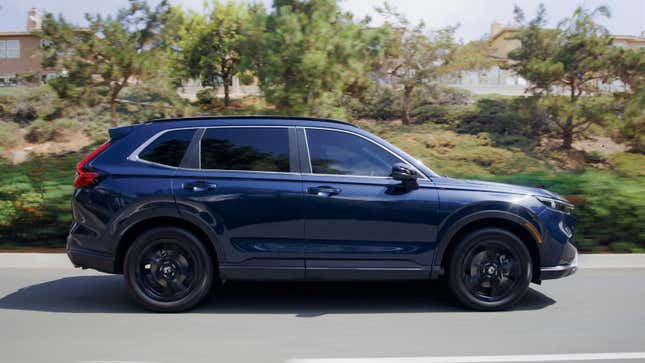
In case you’ve been driving around with your eyes closed for the last 25 years, the Honda CR-V is the Japanese automaker’s midsize SUV. It launched in America in 1997 and has been a hit basically ever since. Over the ensuing 25 years, it spawned five generations, and a hybrid model was added to the range in 2020.
This is the sixth-generation CR-V, which will begin hitting the road in 2023. The new model boasts a fresh design, a more spacious interior and a choice between a 1.5-liter Turbo model and an all-new hybrid setup. The hybrid model comes in either front-drive or all-wheel drive Sport trim, or the top-of-the-range AWD Sport Touring, which is the model I drove.
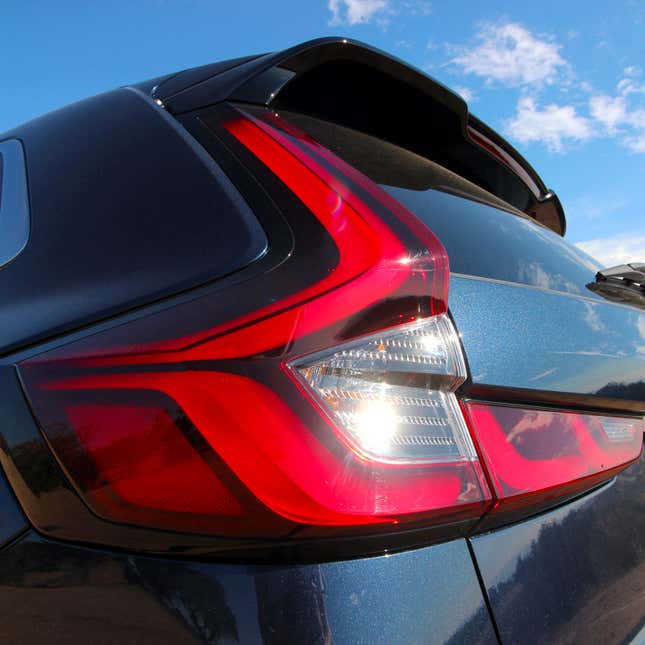
No matter which model you chose, the first change that you notice is the design. At times, Honda’s styling has felt a little lost in recent years, but the company has been doing a good job of bringing cohesion back to the range with updates to models like the Civic and HR-V. This continues with the new CR-V, I’m pleased to say.
Gone is the curvy, big-chinned look of the fourth and fifth generation. Now, Honda is all about clean lines and sharp angles. At the front, there’s a longer hood, a cross-hatch grille and a new headlight array, which gives the CR-V an angry stare.
In profile, the roofline has been flattened and there’s a sharper angle to the rear end, which also loses the weird protruding taillights of the previous generation. Honda did keep the split design that sees the taillights flank the tailgate and fork off at 90 degrees. It’s an updated LED array that looks neat and new while keeping the back end familiar.
All these new body panels and design updates help to mask the fact that the new CR-V is bigger than the outgoing model. The wheelbase is 1.6 inches longer and the whole car has gained an extra 2.7 inches in length. The new CR-V is also 0.4 inches wider than the previous generation.
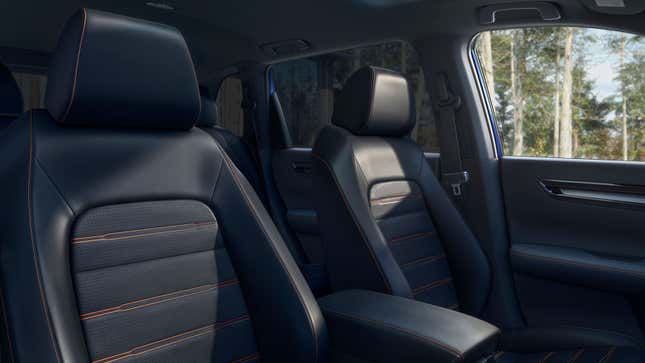
This gave Honda space to redesign the cabin, which executives said was the first priority. There’s a new, larger center console screen, redesigned seats and improved soundproofing throughout the cabin.
On top of all this, there’s also a nice new set of black, 19-inch alloy wheels for the Sport Touring model and some new paint colors, including the canyon river blue metallic finish you see here.
2023 Honda CR-V Hybrid: What’s Under the Hood?
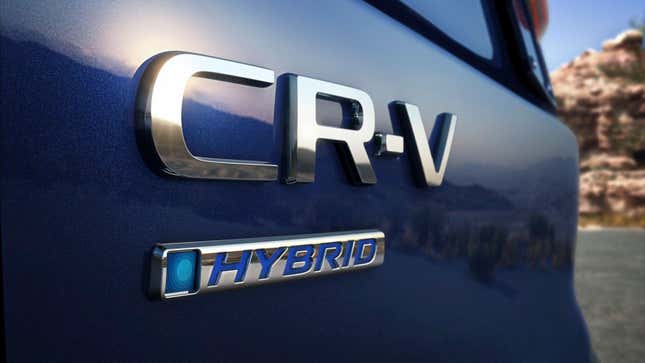
On the Turbo models, Honda updated the 1.5-liter turbocharged four-cylinder familiar from last year’s model. Capable of producing 190 hp, that motor can be ordered with either front- or all-wheel drive in both the EX and EX-L trim levels. In each case, you have just one choice when it comes to transmissions: a CVT.
But the big talking point here is the Hybrid, which comes with an all-new powertrain in ‘23. Both the Sport and Sport Touring variants come with a 2.0-liter four-cylinder and a two-motor hybrid setup that produces a total of 204 hp. That’s three more horses than the old model and 14 more than the 2023 Turbo, making the new hybrid the most powerful CR-V variant ever.
The front-drive hybrid CR-V gets an EPA rating of 40 mpg combined, while the all-wheel drive model loses 3 mpg. Over my day driving the AWD Sport Touring model, I didn’t quite reach that number. In the morning, when I was working my way through the hills and valleys of Southern California, I topped out at 31.3 mpg. The afternoon, which had a little more highway and city-center driving (where regenerative braking pays off), peaked at 33.5 mpg.
To aid that economy, paddles on either side of the steering wheel allow you to switch from full one-pedal driving down to just a hint of regenerative braking.
2023 Honda CR-V Hybrid: How it Drives on the Road
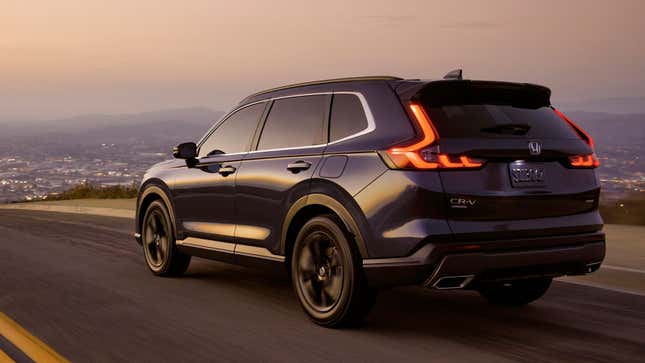
Honda wants you to know that the CR-V Hybrid is about more than just fuel economy. The company is adamant that the new hybrid drivetrain is also meant to make this the most fun CR-V yet. You’ll be as pleasantly surprised as I was to find out that it’s actually quite a hoot to drive.
The CR-V Hybrid comes with four driving modes: normal, econ, snow, and a new sport setting, which Honda says gives you a more responsive accelerator and “sporty active sound control.” You change between these four settings via a toggle switch next to the shifter, which thankfully is a real lever rather than a PRNDL dial or assortment of buttons.
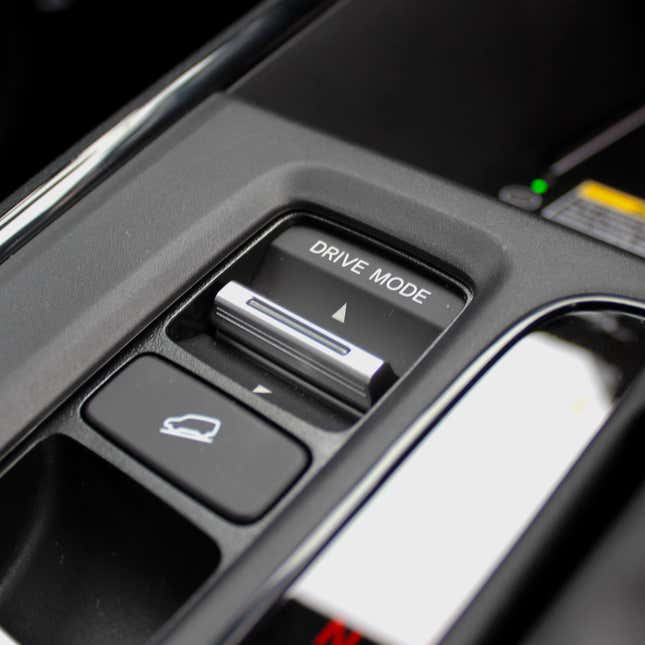
When I pulled off the highway and hit the hills around Santa Barbara, the sport setting elevated the CR-V. The more responsive throttle was really noticeable on the twists and turns around California’s wine country. And when I had the chance to cover the same roads in a lower-spec Turbo model without the sport mode, it felt like there was a little something missing.
Back in the hybrid, the brakes were sharp and the car was quick to get back on the power coming out of a tight turn. What’s more, the suspension did a great job at soaking up undulations, bumps and potholes. It had a nice amount of movement to it, and it didn’t roll or lumber around to the same extent as something like a Kia Sorento, but just sort of shrugged off any change in surface.
When the time came to re-join the highway, the CR-V had oodles of acceleration to get up to freeway speeds – even with the surprisingly short on-ramps around Santa Barbara. On the highway, Honda’s midsize SUV is a pretty nice place to be.
2023 Honda CR-V: Interior
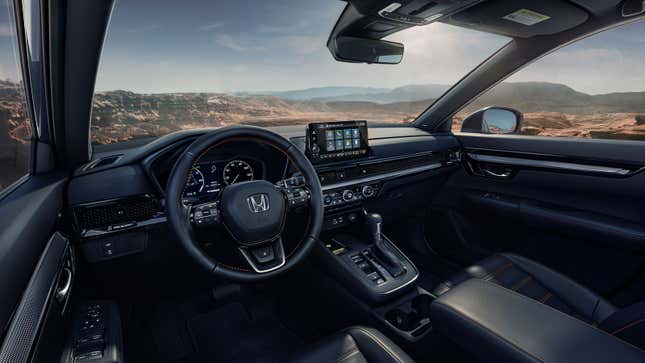
Inside, the new CR-V is pretty sleek. The first thing you notice when you climb in is that updated dashboard, which now features a cool honeycomb vent strip running the full width of the cockpit. It looks slick, but I do worry how hard it will be to keep dust-free.
Elsewhere, there’s a new 9-inch touchscreen in the center console, with a dedicated volume dial as well as physical home, back and skip buttons. This is compatible with Apple Car Play and Android Auto, which is all handled wirelessly in the Sport Touring model. At this spec, you also get a wireless charging pad to keep your phone topped up. Honda has also opted for some very satisfying dials for the AC controls.
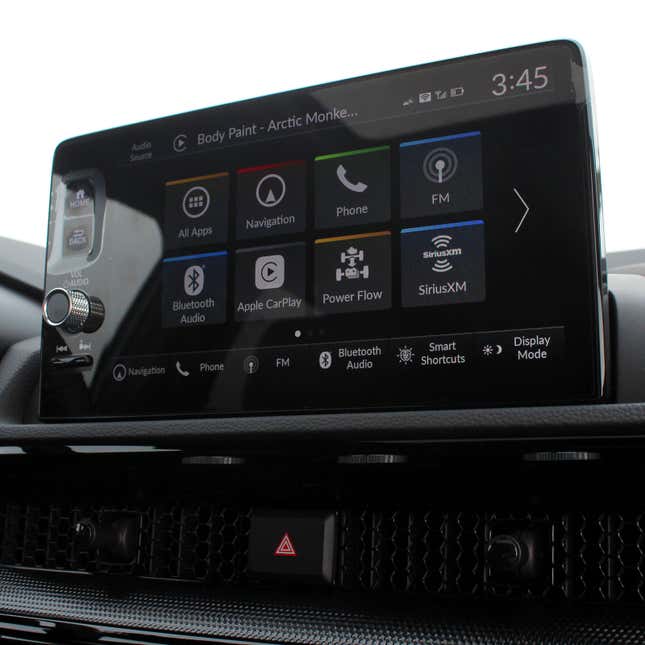
The cabin houses Honda’s latest seats, which it says feature an all-new frame design and cushioning to improve posture and stability. As someone coming off the back of a pretty painful lumbar injury, I can confirm that these are comfy, supportive seats.
From the driver’s seat, you’ll also notice the improved visibility out the front of the 2023 model. You get a great view of the road around you, which makes navigating narrow streets and parked cars a breeze. Honda says this was achieved by narrowing the pillars and shifting the mounts for the side mirrors.
In the back, there’s now an extra 0.6 inches of legroom. That’s not enough to instantly notice, but it did feel spacious when I clambered back there to test out the new reclining rear seats. That’s right, Honda has given the back row eight positions of recline, so your back-seat passengers have space to relax on a long drive.
Everything feels a little nicer in the cabin compared with the outgoing model. The dark leather with contrast stitching looked sweet in my review unit, and the improved sound damping does a great job at reducing road noise.
What’s more, there are also little upgrades like a new, faster electric tailgate, which can be triggered by waving your foot around the rear bumper. And, cargo space in the trunk has increased by three cubic feet.
2023 Honda CR-V Hybrid: Is it Good Enough to Upgrade?
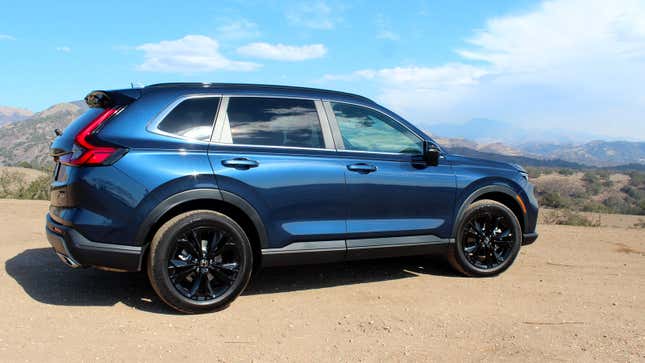
The improvements over the outgoing model are plain to see in the ‘23 CR-V. This is a personal preference, but the styling alone would have me eager to replace an aging fifth-generation with this new incarnation of Honda’s crossover. It looks sleek, and worthy of its somewhat higher price tag.
There are three different entry points for the CR-V Hybrid. The base level, front-wheel-drive Sport starts at $32,450, while adding all-wheel-drive to the Sport bumps the price up by $1,500. The model I drove was the top-of-the-line Sport Touring CR-V Hybrid, which starts at $38,600. All three models carry a $1,245 destination charge.
Overall, the fuel economy has improved, the interior feels more grown up and the driving experience is refined to the point that this is a genuinely fun vehicle to drive – especially when you compare the Sport models with the non-hybrid Turbo cars.
All in all, Honda has made a worthy successor to the wildly popular CR-V, and there’s no doubt that it will continue to sell like hotcakes for years to come.